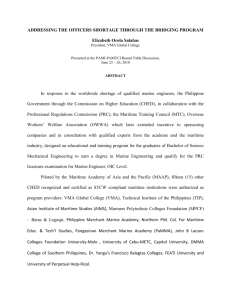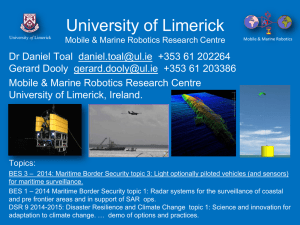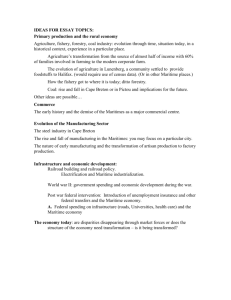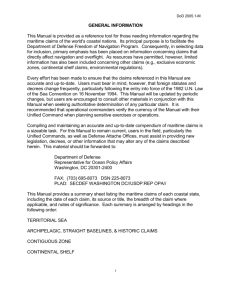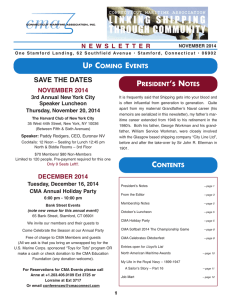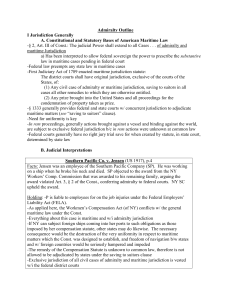Lesson 13a Discovering Maritime Transportation LP
advertisement
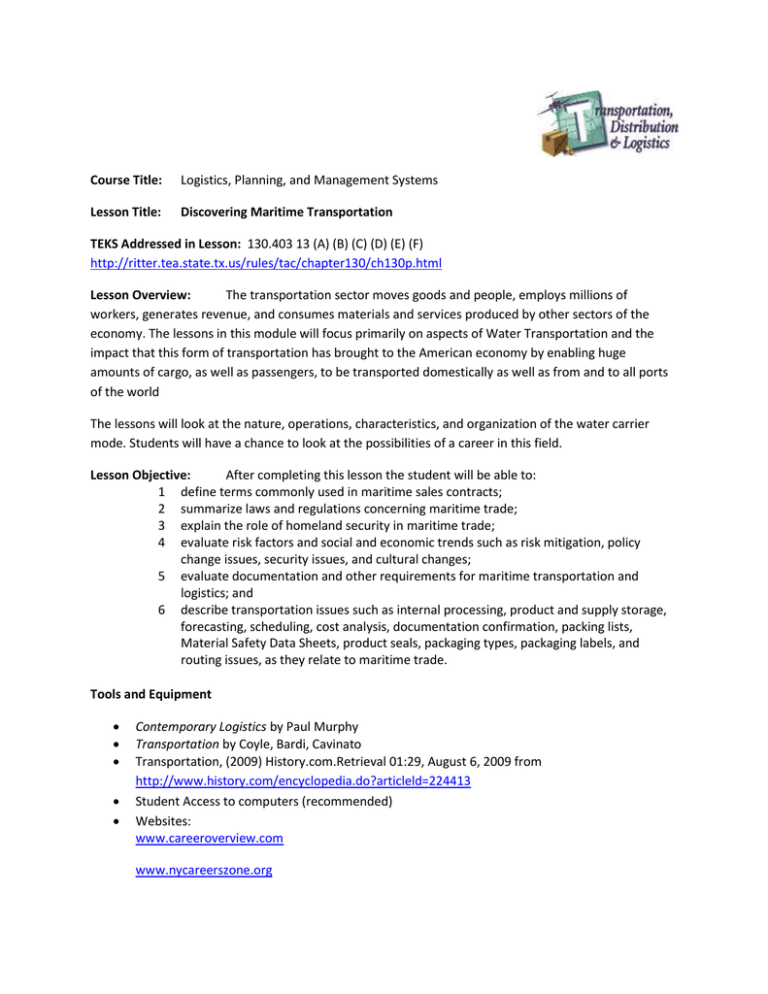
Course Title: Logistics, Planning, and Management Systems Lesson Title: Discovering Maritime Transportation TEKS Addressed in Lesson: 130.403 13 (A) (B) (C) (D) (E) (F) http://ritter.tea.state.tx.us/rules/tac/chapter130/ch130p.html Lesson Overview: The transportation sector moves goods and people, employs millions of workers, generates revenue, and consumes materials and services produced by other sectors of the economy. The lessons in this module will focus primarily on aspects of Water Transportation and the impact that this form of transportation has brought to the American economy by enabling huge amounts of cargo, as well as passengers, to be transported domestically as well as from and to all ports of the world The lessons will look at the nature, operations, characteristics, and organization of the water carrier mode. Students will have a chance to look at the possibilities of a career in this field. Lesson Objective: After completing this lesson the student will be able to: 1 define terms commonly used in maritime sales contracts; 2 summarize laws and regulations concerning maritime trade; 3 explain the role of homeland security in maritime trade; 4 evaluate risk factors and social and economic trends such as risk mitigation, policy change issues, security issues, and cultural changes; 5 evaluate documentation and other requirements for maritime transportation and logistics; and 6 describe transportation issues such as internal processing, product and supply storage, forecasting, scheduling, cost analysis, documentation confirmation, packing lists, Material Safety Data Sheets, product seals, packaging types, packaging labels, and routing issues, as they relate to maritime trade. Tools and Equipment Contemporary Logistics by Paul Murphy Transportation by Coyle, Bardi, Cavinato Transportation, (2009) History.com.Retrieval 01:29, August 6, 2009 from http://www.history.com/encyclopedia.do?articleld=224413 Student Access to computers (recommended) Websites: www.careeroverview.com www.nycareerszone.org www.targetjob www.transportationcareerguideandwebresources.com www.youtube.com – re transportation issues Other Internet articles as specified in each individual module. Key Terms / Vocabulary Bunkering - Fueling a ship or vessel DOT- Department of Transportation FMC – Federal Maritime Commission Intermodal – The combination of more than one mode of transportation and results in the interchange of equipment Maritime – Connected with the sea OSHA- Occupational Safety & Health Association Port - A town or city with a harbor where ships load or unload BOM – Bill of Materials FMCSA – Federal Motor Carrier Safety Association FOB – Free on Board or Freight on Board shipping term that specifies which party (buyer or seller) is responsible for shipment and loading costs KDF – Knocked down Flat to reduce an article’s normal cubage RFP - Request for Proposal Tankerman – Refers to several endorsements or qualified ratings to Merchant Marine Documents (MMD). Tankerman endorsements require qualifying experience, training in firefighting and cargo (dangerous liquids or liquefied gasses), and passing an exam administered by the U.S. Coast Guard. 3PL Providers – Third Party Logistics Providers of Transportation and Logistics services Interest Approach/Anticipatory Set Show students the Extreme Engineering: Container Ship found at http://www.youtube.com/watch?v=Eg4lnKPBcqk (1 of 6 parts). There are six parts on YouTube. You may consider making a worksheet to engage students will viewing the show. Teaching Plan and Strategy / Presentation of New Material 1. Use PPT about Maritime Transportation. 2. What is Involved in Water Transportation Operations? Discuss with the class the history of water transportation and brainstorm some aspects that current water transportation has to deal with. Discuss various water transportation careers. Have students pick one of these careers that interests them. Then have the students write a brief paragraph on that career stating why that career is interesting to them. Discuss with the class maritime transportation using the Discovering Maritime Transportation PowerPoint Presentation. Handout the Discovering Maritime Transportation Presentation Assignment and review with students. Partner up the students and give the students time to complete their presentations. They will need computer/internet access to complete the research and presentation. Depending on class size, have your students give their 5 minute presentations. 3. Marine Transportation Managers Class discussion on the services that a Marine Transportation Manager would be involved with such as chartering, crewing, maintenance & repair, fueling and provisioning. Discuss with the class the training, licensing, and education needed to become captains, mates and pilots of ships and water vessels. 4. Cargo Vessel Crews Have students determine the average length of duty for ship crews, tug & barge crews, and hours worked each day. Have students write down an explanation of the duties of workers on supply vessels. Lead a class discussion on the type of training and certification needed for each position found onboard a typical deep-sea merchant ship. 5. Tankerman Services Lead a class discussion on the different steps that tankermen go through in the handling of dangerous materials. Have students write down an explanation of the duties of workers on supply vessels. Lead a class discussion on the type of training and certification needed for each position found onboard a typical deep-sea merchant ship. 6. Marine Vessel Dispatching & Tracking Operations Have students research the United States Coast Guard ‘s Houston Vessel Traffic Service and discuss the mission and services offered to the marine industry and shipping public. Divide the class into groups and have them prepare a mock daily log for a small barge fleet using information learned from the above listed resources. Compare the different group daily logs for completeness and/or omissions, etc. 7. Pilots of Marine Vessels Break students into groups and have them write an explanation of the various different waterway pilots. Also have them define the respective roles and responsibilities of the Pilot and the Ship Master. Have the student groups develop an outline of the required information that a pilot must give to the Vessel Traffic System prior to getting underway. 8. Vessel Traffic Control Students break into groups and use the internet to research the role of VTS and what traffic controller certification entails. Students research career opportunities for water traffic controllers. Compare the different group daily logs for completeness and/or omissions, etc. 9. Marine Cargo Inspectors Students get broken into teams/groups to research about cargo inspectors. Possible questions for students to consider are: o Why should cargo be inspected? o 10 duties that a cargo inspector performs. o What are some hazards of loading/unloading cargo? o Where can you find a list of regulations for cargo storage? Student groups write a short paper about their findings. Class discussion/recap of the findings of the research. 10. Inland Barge and Ocean Transportation Break students into groups. Each group should compare and contrast transporting goods by barge and by ocean (include: transit time, maximum volumes that can be handled, and cost) for between 2 specified points (such as Houston, TX to Mobile, AL). Groups write a short paragraph or two on which method is better suited to for this shipment and why. Class discussion of the findings. Allow each group to share the route that they felt was best. Evaluation / Summary Each group of students develops a presentation concerning one commodity or trade good that comes to America from abroad, and identifies the steps and impacts in the transportation process. This evaluation process also addresses certain aspects of TEKS 9 and 10: (9) The student applies problem-solving, mathematical, and organizational skills to maintain financial and logistical records. The student is expected to: (A) discuss project proposals; (B) develop and maintain records; (C) collect and organize data in graphs, tables, charts, and plots; (D) analyze and interpret data from graphs, tables, charts, and plots; (E) maintain appropriate financial records such as journals, inventories, income and expense logs, and financial statements and balance sheets; and(F) conduct formative and summative reflective and financial analyses on project learning objectives and records in order to problemsolve for the future. (10) The student uses information technology tools to access, manage, and create information. The student is expected to: (A) use personal management software, email applications, and Internet applications; (B) use word-processing, database, spreadsheet, and presentation software; (C) use collaborative or virtual meeting software; (D) use or explain the benefits of Geographic Information Systems and Global Positioning Systems hardware and applications; and (E) use computer-based equipment to manage resources. References/Additional Materials / Extended Learning Opportunities/ Enrichment College & Career Readiness Standard ©Texas Education Agency, 20141


